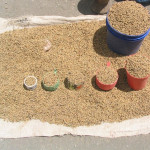Conservation Status Research
Project Brief: Plant Utilization Scoping Project, Monduli District
Joint Activity: UNDP/GEF Cross-Border Biodiversity Project and Terrawatu with additional support from UNDP Small Grants Tanzania.
In April 2001, Terrawatu, together with local Tanzanian NGO, Aang Serian, and GIFTS of Health in the UK began fieldwork in the Monduli District of Northern Tanzania. The research team spoke to male and female elders, age-set leaders, and traditional herb sellers in a Maasai village and a Wa-Arusha community about their medicinal plant species. This project documented the indigenous use of plants and trees for medicinal, ritual, and nutritional purposes and gathered data on the conservation status of these resources. Results of this project were used to determine the connection of plant biodiversity to indigenous culture and management of resources based on customary laws of the community.
JUSTIFICATION
The World Health Organization has consistently estimated that 70-80% of Africa's population relies on traditional systems of medicine for its basic healthcare needs. In Tanzania, over one thousand plant species are traditionally utilized as sources of human and veterinary medicine. Their uses include prevention and treatment of malaria, bacterial and viral infections, and pregnancy and birth-related ailments. Although the Arusha Region of northern Tanzania has one of the richest flora in tropical Africa, the majority of medicinal plant knowledge remains within the communities and has not been systematically documented. The indigenous peoples who traditionally use these plants are rapidly losing their language and foundational knowledge.
OBJECTIVES
The aims of scoping project were:
1. link the already collected Cross Borders information to local knowledge of the plant species, their medicinal uses, and traditional harvesting strategies;
2. groundtruth the widespread perception that supplies of priority plant species are decreasing in the district, and identify the threats to their preservation from both inside and outside the communities;
3. compare and contrast a rural and a peri-urban community in order to discern the influence of urbanization on patterns of plant utilization; and
4. provide a foundation for future work in this area.
LINKAGES
· Tropical Pesticides Research Institute, Ngaramtoni, Arusha
· Natural Resources Division, Monduli District Council
· Institute of Traditional Medicine, Muhimbili Medical Centre, Dar es Salaam
OUTPUTS
Resulting from Fieldwork
(a) List of species (local and scientific names), habitats, uses. Collection of sample species by botanists.
(b) Description of patterns of use (e.g. medicinal, ritual, nutritional, cosmetic, hygienic, construction, fuel, fodder, etc.), priority importance, cultural significance, perceived availability, sustainability of harvest.
Resulting from Data Analysis
(c) Assessment of global significance of medicinal species and indigenous ecological knowledge.
(d) Assessment of potential links with existing resource management strategies.
The final project report authored by Dr. Tanya Pergola and Gemma Burford, MSc, was completed and translated into Kiswahili and Maa. A de-briefing was held in the villages of Olarash and Eluay where villagers provided us with comments and suggestions for future work.
Click here for summary paper of project report


